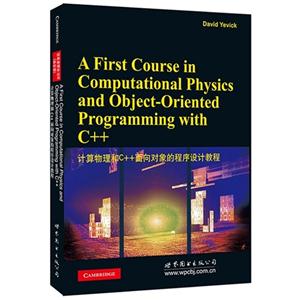-
>
全国计算机等级考试最新真考题库模拟考场及详解·二级MSOffice高级应用
-
>
决战行测5000题(言语理解与表达)
-
>
软件性能测试.分析与调优实践之路
-
>
第一行代码Android
-
>
JAVA持续交付
-
>
EXCEL最强教科书(完全版)(全彩印刷)
-
>
深度学习
计算物理和C++面向对象的程序设计教程 版权信息
- ISBN:9787510087738
- 条形码:9787510087738 ; 978-7-5100-8773-8
- 装帧:一般胶版纸
- 册数:暂无
- 重量:暂无
- 所属分类:>>
计算物理和C++面向对象的程序设计教程 本书特色
现代c++编程有关的科学编程的众多方面。由于这本教程的独特性,对于计算科学的学生和科学编程人员,其作用不可估量。尤其值得关注大篇幅的附录,这些附录都具有极强的应用性,不可忽视。 目次:(**部分)c++程序基础;安装和运行c++程序运行环境;计算机和软件结构;基本概念;**个程序;面向对象分析入门;c++面向对象程序句法;逻辑控制和迭代;基本函数性质;列和矩阵;输入和输出流;(第二部分)数值分析:数值错误分析;积分;求解程序;微分方程;线性代数;(第三部分)高等面向对象程序:参考资料;指针和动态存储分配;高等存贮处理;静态关键词、多继承和虚继承、模板和stl库;c++中的程序优化;(第四部分)科学编程案例:蒙特卡洛方法;抛物偏微分方程解;附录a:matlab概述;附录b:borlandc++编译器;附录c:linux/windows指令行c++编译器;附录d:从c++zhong提取fortran程序;附录e:c++编码标准。 读者对象:计算物理、计算科学以及相关领域的学生、老师和科研人员。
计算物理和C++面向对象的程序设计教程 内容简介
现代C++编程有关的科学编程的众多方面。由于这本教程的独特性,对于计算科学的学生和科学编程人员,其作用不可估量。尤其值得关注大篇幅的附录,这些附录都具有极强的应用性,不可忽视。 目次:(**部分)C++程序基础;安装和运行C++程序运行环境;计算机和软件结构;基本概念;**个程序;面向对象分析入门;C++面向对象程序句法;逻辑控制和迭代;基本函数性质;列和矩阵;输入和输出流;(第二部分)数值分析:数值错误分析;积分;求解程序;微分方程;线性代数;(第三部分)高等面向对象程序:参考资料;指针和动态存储分配;高等存贮处理;静态关键词、多继承和虚继承、模板和STL库;C++中的程序优化;(第四部分)科学编程案例:蒙特卡洛方法;抛物偏微分方程解;附录A:Matlab概述;附录B:BorlandC++编译器;附录C:Linux/Windows指令行C++编译器;附录D:从C++zhong提取Fortran程序;附录E:C++编码标准。
计算物理和C++面向对象的程序设计教程 目录
计算物理和C++面向对象的程序设计教程 作者简介
David Yevick是国际知名学者,在数学和物理学界享有盛誉。本书凝聚了作者多年科研和教学成果,适用于科研工作者、高校教师和研究生。
- >
龙榆生:词曲概论/大家小书
龙榆生:词曲概论/大家小书
¥8.7¥24.0 - >
苦雨斋序跋文-周作人自编集
苦雨斋序跋文-周作人自编集
¥6.1¥16.0 - >
大红狗在马戏团-大红狗克里弗-助人
大红狗在马戏团-大红狗克里弗-助人
¥5.2¥10.0 - >
二体千字文
二体千字文
¥14.0¥40.0 - >
山海经
山海经
¥18.7¥68.0 - >
随园食单
随园食单
¥16.4¥48.0 - >
小考拉的故事-套装共3册
小考拉的故事-套装共3册
¥36.7¥68.0 - >
我与地坛
我与地坛
¥16.4¥28.0
-
C程序设计(第五版)
¥18.6¥49 -
C语言从入门到精通-(第4版)
¥34.5¥69.8 -
C++程序设计语言(第4部分:标准库)
¥58.9¥89 -
C语言项目开发全程实录(第3版)
¥68.4¥89.8 -
不良情绪应急处理包--孤独感
¥12.9¥30 -
不良情绪应急处理包--精神内耗
¥12.9¥30
上海花园动植物指南
¥45.1¥98.0分布式应用系统架构设计与实践
¥48.9¥79.9中医急诊学·全国中医药行业高等教育“十四五”规划教材
¥62.9¥72.0当代生命伦理学研究(上下卷)
¥180.7¥278.0儒藏:精华编(二七八)
¥888.0¥1200.0


















